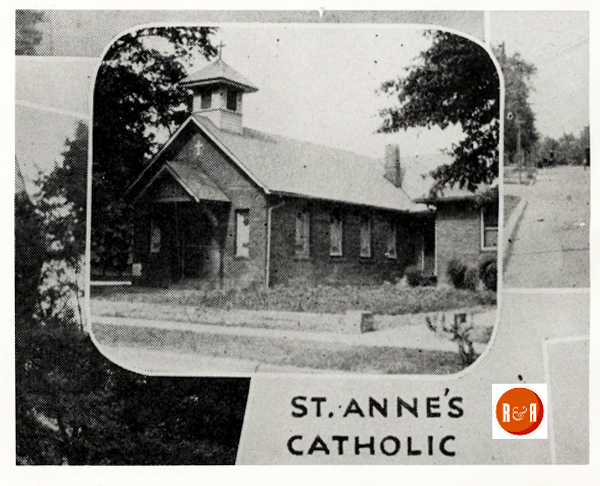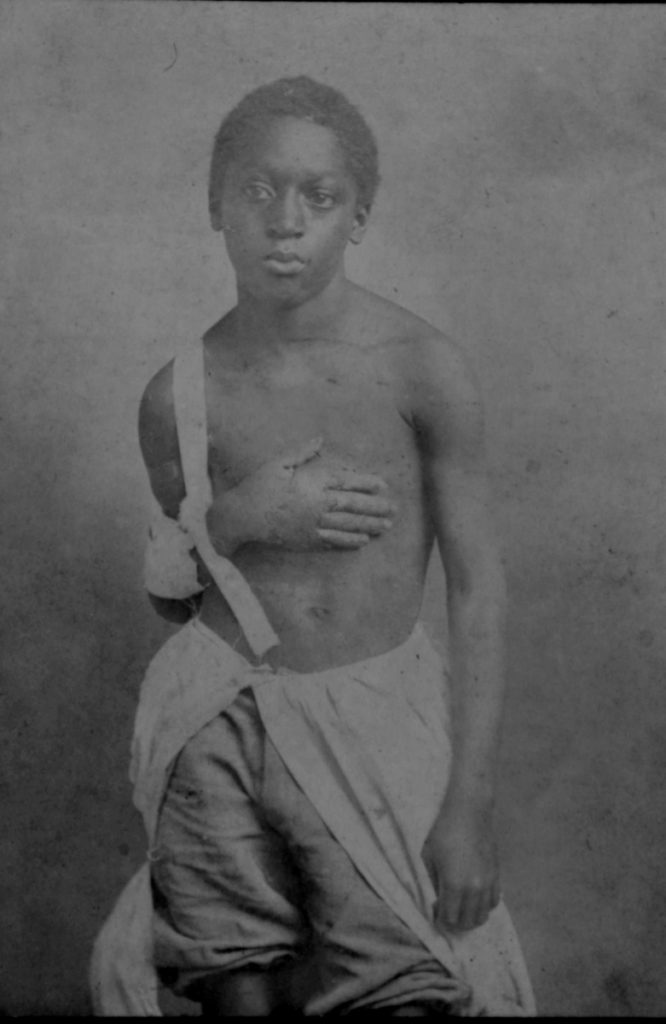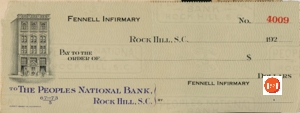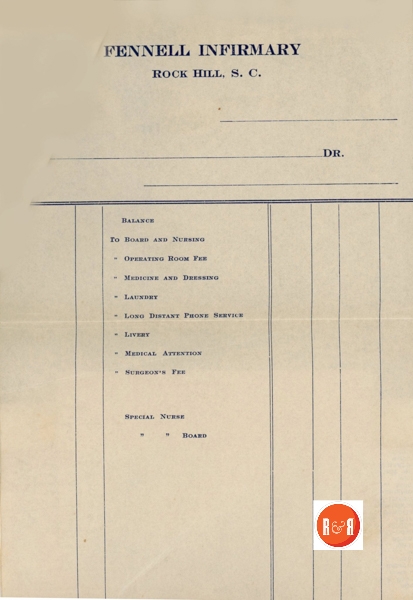360 North Confederate Avenue

The Rock Hill Record reported on March 1, 1909 – “J.J. Keller and Co., was awarded a contract today to build a new hospital for Dr. W.W. Fennell to be located on the White property near White Street.”
Rock Hill’s private hospital owned by Wm. Wallace Fennell, M.D. and later by Dr. W.B. Ward….
City Directories and History: 1922/23 – R.W. Young, Fennell Infirmary, W.W. Fennell,
Rock Hill has been fortunate to have been served by outstanding physicians. One of these was Dr. William Wallace Fennell, a native of
the Richburg area of Chester County who settled in Rock Hill in 1897. Dr. Fennell was influenced by his grandfather, Dr. John Bell Fennell, and his father, whose medical education was cut short by the Civil War. Wallace, born in 1869, was educated in local schools and worked his way through a business degree at the University of
Kentucky, graduating in 1887. He returned to Chester County and worked for five years at the Fishing Creek Manufacturing Company in Lando. (The Rock Hill Herald reported on Oct 24, 1896 – That Dr. Fennell left for New York City, where he will take a special course in the Polyclinic Institute.) Deciding to enter the medical profession, he conferred with Dr. David Lyle in Chester County and received some basic education in anatomy from him. He also fell in love with Lyle’s daughter, Mary Rose Lyle, who was ten years his junior.

James Flenniken Fennell father of Dr. William Wallace Fennell. Photo taken with his Confederate uniform in 1861 – Courtesy of the Ratterree Collection, 2015
Fennell received his medical degree from the South Carolina Medical College (now MUSC) in 1895 and did post graduate work in 1899 New York City under Dr. Walker Gill Wylie at the Belleview Hospital. Wylie, also a native of Chester County and a cousin of Mary Rose Lyle, was so impressed with Fennell’s skills as a surgeon that he urged him to stay in New York. However, he wanted to return home, and practiced a year in Edgemoor before moving to Rock Hill in 1897. He and Mary Rose Lyle were married in 1899. He worked at first with Dr. William Frank Strait, who had a practice in his home on Johnston Street.
The Fennells lived in several locations in Rock Hill. Dr. Fennell boarded with Mrs. S. Frew on Hampton Street, and Mary Rose joined him there after their marriage. Within a year, they purchased the former Episcopal Parsonage at the corner of Hampton Street and Elm Avenue, where their first child, Althea was born. Soon, Dr. Fennell converted portions of the house into a hospital or clinic. The Robbins – White Tour Booklet states, “The next house on Elm Avenue was the Forney house. Mr. Forney was the ticket agent for the Southern Railway in Rock Hill. On the same side of the street, next to’ the Forney house, stood the two-story frame house used as the rectory for the Episcopal Church of Our Savior. At one time Dr. W. W. Fennell, prominent surgeon, lived in this house. It has been said that Doctor Fennell performed several operations in this house….”
Rock Hill had no public hospital until 1940, and many physicians operated hospitals in their homes or rented houses. Dr. Fennell employed nurses and began seeing patients of all kinds, often performing surgeries in the clinic. His skill as a surgeon became widely known. In 1904 and 1905, Fennell studied at the University of Heidleburg Medical School in Germany to learn the latest surgical techniques in Europe.

The Fennell Infirmary, later the St. Philips Hospital had a long history of providing excellent care for Rock Hillians. This diagram shows the Fennel home at 334 North Confederate and the hospital next door on the same lot. Sanborn Insurance Map 1926 – 1959. Courtesy of the Galloway Map Collection
In 1903, several local doctors joined together to develop a new hospital, with Capt. William Lyle Roddey helping to raise the funds. Dr. Fennell joined this group, and worked in the new facility for a few years. The new Rock Hill Hospital was located on Clay Street (now Charlotte Avenue) near the Overhead Bridge. About the same time, the Fennells moved to the Oakland Avenue area to be nearer the new hospital and the number of friends and relatives who had moved to the new Oakland development over the past few years. Their new home was the former home of Mr. and Mrs. William Joseph Roddey. It had been built in 1896 at the corner of Oakland and Wilson in the high Queen Anne Style.

A wonderful view of the Confederate Park main building and swimming area. This building stood in the next corner near the Fennell’s Home and the Hospital. It originally served as a pasture for Rock Hillian’s to graze their livestock and was later ca. 1870s sold by Ann White to the City of Rock Hill as a municipal park. Images courtesy of the Jack Tucker Photo Collection – HRH.
Within ten years, the Roddeys decided they wanted a newer, larger home, but did not want to leave the enclave of relatives and friends on Oakland Avenue. The solution was to move the home and build a new one in its place. The Roddeys were relatives and close friends with the Fennells, and in 1906 the adjacent lot was sold to the Fennells and the home moved from 148 Oakland Avenue to its present location at 128 Oakland Avenue. When the Fennells bought the home, it was altered to reflect the Classical Revival style, which had replaced the Queen Anne style in popularity. During the construction, the Fennells lived for a few months in the London family home at the corner of Oakland Avenue and Chatham Street. The large new home on Oakland afforded room for the growing family and for Dr. Fennell’s office and examining room. (Additional details further below.)

Early image of the Infirmary, courtesy of the Fennell Collection – 2021

1940s view of the Fennell Infirmary – Courtesy Lyle Huffstetler, 2021
Within a few years, Dr. Fennell decided that he wished to develop his own hospital where he could have greater control over the surgical procedures and could provide a training school for nurses. A bequest from the will of Mary Rose’s uncle John Lyle allowed the couple to purchase a large parcel on North Confederate Avenue. Here was established the Fennell Infirmary in 1909, the first fully functioning hospital in Rock Hill. The large wood structure had 50 patient beds, a ward for African American patients, an operating suite, a dining room, kitchen, and laundry. The Infirmary was two stories facing Confederate Avenue and because of the sloping lot, stood three stories in the rear. The site had the advantage of being close to the railroad and next to Confederate Park. To the rear was a large area which housed a hot house, rose garden, and pastures for pet deer and family horses. The family then built a larger home adjacent to the Infirmary in 1910 and sold the Oakland Avenue home to Dr. W. C. Patrick, a Rock Hill dentist. The new house was large enough to house the family and the nurses training with the Infirmary.
Dr. David Lyle, Jr., Mary Rose’s brother worked with Fennell to establish a nurses’ training facility. Dr. Fennell recruited and trained nurses to assist in the operating room. Other physicians worked at the Infirmary, including Dr. W. R. Blackmon and Dr. Robert Sumner. The Fennell Infirmary quickly gained a reputation as one of the foremost centers for surgery in the Carolinas. It was the most fully equipped and staffed hospital in the area including York, Chester, Lancaster, and Kershaw counties. Patients came from all over the Piedmont of the Carolinas. Dr. Fennell was known for innovative and creative surgery techniques, and often did follow-up procedures when other surgeons had failed. Dr. Fennell developed a relationship with the rail lines serving Rock Hill. He was surgeon for both the Southern and Seaboard Airline Railroads, and relied on the proximity of the railroad to deliver patients. The Southern even established a “Fennell Infirmary Crossing” nearby where the line crossed Confederate Avenue. He traveled on the railroad to perform surgeries when patients could not reach the hospital, the rail lines being cleared to allow his car to pass.

Images courtesy of and from the McGarity Collection of the Fennell Home, St. Philip’s Hospital. The nuns who operated the hospital and their leisure time spent at Dr. Alton Brown’s Lake Wylie house on Big Allison Creek – ca. 1950s. Courtesy of the McGarity Collection – 2015





Dr. Fennell became a charter member of the American College of Surgeons and a member of the Medical Board of South Carolina. He received a number of accolades from his fellow surgeons, with a national reputation.
In 1924, Dr. Fennell suffered a stroke and had to end his practice. The Fennell Infirmary was leased to Dr. W. B. Ward and was operated for several years. In 1934, the Roman Catholic Church opened the Oratory of St. Philip Neri in Rock Hill and began outreach in the area. Local physicians met with the Bishop of Charleston concerning establishing a hospital in the area. As a result, the Fennell Infirmary was sold to the Sisters of Saint Frances in 1925, and was reopened as St Philips Hospital. St. Philips functioned as the principal hospital in Rock Hill until York County Hospital was opened in 1940 on Ebenezer Road.
Contributed and written by Paul M. Gettys
Robert Walker shared the following on 9.30.14 – John Ross Burgess, was head of maintenance for many years at St. Philip’s Hospital.
The RH Record reported July 30, 1908 – “The doctors of the city who are the owners of the local hospital held a meeting and decided to discontinue the operation of the same. It has not been a paying institution for some period. Dr. Fennell, however, has already completed plans to give this region a hospital. As a temporary location, he has rented a dwelling house from Mr. J.M. Cherry, located at the rear of his home on Oakland Avenue and is now caring for his patients there. Dr. Fennell contemplates the erection of a hospital building later on…. Aug, 3, 1908 – “Dr. W.W. Fennell has rented the RH Hospital, and is now in complete charge of the institution. He has a large and growing practice and as a surgeon has need of a hospital.”
The RH Record of March 4, 1909 – “Dr. Fennell has asked the City Council to endow a bed for charity patience in the new hospital. The Kings Daughters had endowed beds in the old hospital. (The RH Private Hospital)
The RH Record reported on July 22, 1909 – “A celebration was held, called the Hospital Shower for the opening of the Fennell Infirmary and to raise funds for the Kings Daughters.” On July 29, Dr. W.W. Fennell thanks Rock Hill for the grand opening of his new infirmary. He will leave next week for Rochester, MN to study with the Mayo Brothers in surgery.”
The RH Record reported on July 19, 1909 – “There are quite a number of persons in Dr. Fennell’s hospital, which was opened last week. There are patients from Rock Hill, Lancaster, Yorkville and Charlotte.”
The Rock Hill Record reported on Aug. 9, 1909 – “The Fennell Infirmary is busy with operations performed recently on patients from Stanley N.C., Lincoln Co., N.C., Yorkville, Blacksburg, Hickory Grove, Rock Hill and Lancaster. Other patients are from Elberton, Ga. and Fort Mill. Roy Biggert a boy, had his arm broken at one of the mills in the city, and was sent to the infirmary to have the arm amputated, but the doctors succeeded in saving it and he is doing nicely.”
The RH Record reported on March 25, 1909 – “Contractor J.J. Keller is rushing to complete work on the new hospital for Dr. Fennell. The foundation walls have been completed and a general idea of how the building will look can now be had. It is located in an ideal position, on an elevation surrounded by beautiful trees. The building will be much larger than originally intended as four rooms have been added to the plans. It will be two stories in the front and three in the rear with wide verandas. The walls will be brick finished with a stucco effect. It will be heated by a hot water system and will have bathrooms, a shower bath, and a private septic system. Dr. Fennell hopes to occupy the building in June.”
The Rock Hill Record reported on Dec. 5, 1912 -“Dr. W.R. Blackmon, who recently graduated from the Medical Un. of Louisville Kentucky, and who began the practice of his profession in Kershaw, left last week for Rock Hill, where he has accepted a position as house physician at the Fennell Infirmary. This is an excellent recommendation for Dr. Blackmon and while we regret to lose him as a citizen of Kershaw, we wish him every success in his new field of work.”
The Herald reported on Aug. 14, 1914 – “that W.W. Fennell announced a further enlargement of his hospital to include at least several additional rooms. He has contracted with L.F. Waldrop to place a hot water heating plant in a greenhouse which will be constructed. It will about 100 ft. long and will be used for growing flowers and vegetables in the fall and winter.”
The 1915-16 store ledger of the McElwee Company stated that Fennell Infirmary as well as Dr. W.W. Fennell each had accounts at the store during this period.
The Rock Hill Record reported on Feb. 18, 1929 – “Dr. E.E. Herlong arrived from Florence S.C., and will be associated with Dr. W.B. Ward of the Fennell Infirmary. Dr. Herlong specializes in urology and x ray work. He is a graduate of Wofford College and the Medical College of Charleston and has five years of experience. He and his wife and child currently have an apartment in the home of Mr. and Mrs. John A. Black. They will soon move into the home of Mr. and Mrs. Blackmon as their permanent residence.”
Image of Dr. W.W. Fennell (rt) and young surgeon Dr. W.B. Ward (left – operating), performing surgery on a massive growth. Date unknown. Courtesy of the Fennell Collection
Dr. and Mrs. W.B. Ward practiced medicine for 50 years, shown at his retirement party; flanked by associates: Frank and Martha Fairey (Lt) and Alton and Nelle Claire Brown (Rt). Dr. Ward retired in 1962 and shortly thereafter the hospital ceased operations.
SAINT PHILIPS BEGINS – In April of 1935 “a group of over thirty-five York County physicians met with Father Paul and asked him to use his good offices with the Bishop and some community of hospital sisters to secure for the city a hospital open to all qualified physicians of the community.” In response to this plea, Bishop Walsh contacted the Superioress of the Third Order of Saint Francis in Peoria, Illinois. She came to Rock Hill . In June and made arrangements to buy the Infirmary, then owned by Dr. Ward. In August of 1935 the Sisters arrived, and on September fifth the hospital was blessed by Bishop Walsh. Since then it has been enlarged and its facilities improved a number of times. It continues to minister to the sick in Rock Hill.
WU’s Pettus Archives has an extensive collection of architectural drawings of the hospital by Rock Hill architect, A.D. Gilchrist dating to ca. 1936.

Saint Anne’s Catholic Church was on Saluda Street and served the staff of the hospital and others in the community. Courtesy of the Tucker Photo Collection
Though the priests of the Oratory are in a sense responsible for the purchase of the hospital, they do not have anything to do with its actual operation. In 1935 their greatest effort was made in behalf of boys, there being sixty-five between six and sixteen who were students in the grammar and high school which was conducted at the Oratory. The enrollment grew to one hundred, but upon the opening of the World War II the school was discontinued. The York County Hospital is the culmination of the dreams of many citizens. In 1938 an election was held to determine the will of the people. Of the county in issuing bonds to the amount of $175,000 to be used to build a hospital, a nursing school, and a home for the student nurses. The result of the election was in favor of a hospital. Plans were immediately under way, and on May 15, 1940, the doors of the hospital were open to the public. (Information from: The City Without Cobwebs – Douglas S. Brown, 1953)
Stay Connected
Explore history, houses, and stories across S.C. Your membership provides you with updates on regional topics, information on historic research, preservation, and monthly feature articles. But remember R&R wants to hear from you and assist in preserving your own family genealogy and memorabilia.
Visit the Southern Queries – Forum to receive assistance in answering questions, discuss genealogy, and enjoy exploring preservation topics with other members. Also listed are several history and genealogical researchers for hire.
User comments welcome — post at the bottom of this page.
Please enjoy this structure and all those listed in Roots and Recall. But remember each is private property. So view them from a distance or from a public area such as the sidewalk or public road.
Do you have information to share and preserve? Family, school, church, or other older photos and stories are welcome. Send them digitally through the “Share Your Story” link, so they too might be posted on Roots and Recall.
Thanks!
User comments always welcome - please post at the bottom of this page.




















I really enjoyed reading the article and looking at the pictures. I feel like I have learned so much, especially since I grew up within blocks of Saint’s hospital, was born there, spent a tremendous amount of time at Confederate Park, and wore out several pair of roller skates on the hill beside the hospital. Thanks for the the history lesson and the great memories.
Thank you!
Enjoyed this article and learned so much! So many of the last names of those included in the article are familiar. I actually worked for a couple of ancestors from this group, including John Gardiner Richards Roddey who was an executive with Bank of America. Mr. Roddey went on to open the Bank’s first office in London, under the leadership of Hugh McColl. The last I knew, he now resides at Kiawah Island, SC.
Thank you for this. I would love to learn something about the Children’s Annex, which was a residential home across from the hospital. My understanding is that it began as a foundling home, and was operated by the sisters under Sr. Mathia, the hospital director. I was born in St. Francis Hospital in Greenville in 1951, and spent at least some of my early months in the Annex, eventually adopted by an Air Force couple stationed at Shaw. Please send anything you can to my e-mail. Thanks!
This article was very enlightening and intriguing, however, I am in search of medical records for my mom, who had a breast removed apparently at the St Phillips hospital. Sometime during the late 1940s or early 1950s. Also during that time, she gave birth to a baby girl, who was put up for adoption. I’m in search of that baby girl. Can anyone help me to locate the medical record for my mom who is deceased at this point? Thanks